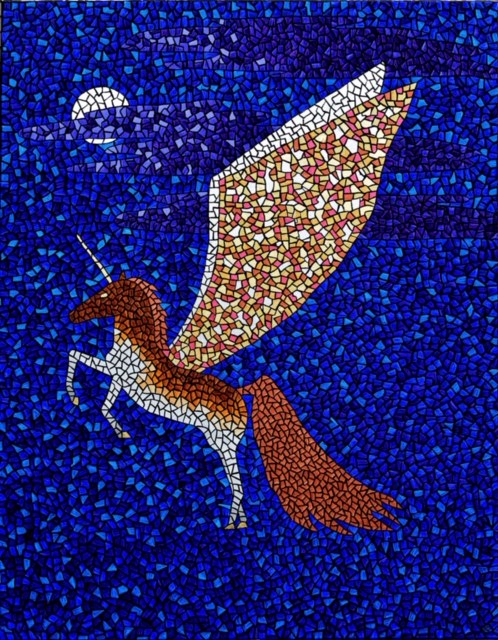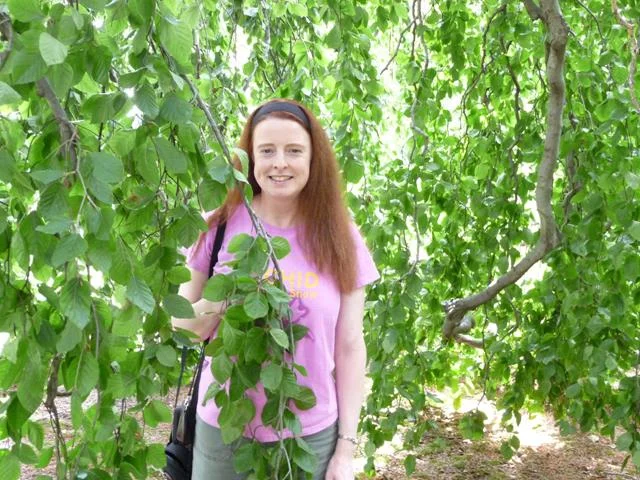Hi, I’m Michael, and welcome to Let’s Talk Process, Issue No. 9! Thanks so much for joining me for the latest issue of my artist interview series. You can read more about me here.
My goal for this series is to dig deeper and explore how various creative people specifically approach their daily work. With that in mind, the questions for Let’s Talk Process center around the unique creative processes of artists & authors, how and when they work, routines, and inspirations.
This issue, I’m thrilled to have artist Tania Wight as my guest!
Hi Tania! To start, tell us a little about yourself and your art.
Tania and her husband, Darren
Hello! I’m lucky enough to live on the beautiful Isle of Wight in the UK (I paint under the name of TaniaWight Art) and have been painting seriously for approximately five years. I am completely self-taught and my style is vibrant, colourful and cheerful. A lot of my work has been inspired by where I live, although pretty much anything can give me the germ of an idea, which I then develop. I work mainly in acrylics; I really like their flexibility and vibrant palette, and I will occasionally use gold and/or silver leaf if I feel something needs some accenting or highlighting. I suppose my style is quite individual; I’ve taken a lot of inspiration from abstract artists such as Gaudi, Kandinsky and Picasso. I also love aboriginal art, glass work and of course, mosaics.
What inspired your beautiful, unique mosaic style? Could you describe the process of how you create one of your pieces?
It came about very organically. When I started painting it was very abstract, I was really just experimenting with colour and shapes, as I lacked the confidence to try anything “better.”
Gradually I started to have a picture in mind, and I tried to represent that with basic shapes, but you could see what the picture was supposed to be.
One day I looked at a painting and thought that the shapes looked a bit like broken tiles or pieces of glass, so I tried to paint a ‘grout’ around them in a pale beige. I wasn’t happy with that so I tried a grey/black, like the lead on a piece of stained glass. Eureka! Haha! After that I developed this more and more, “fine tuning” it if you like.
Now the process I use is to roughly draw the picture in pencil, then I fill in the coloured ‘tiles’ one by one, before outlining each one with black. Finally I give the painting a couple of coats of high gloss varnish. It’s painstaking and takes quite a long time; a large piece will take a month of working every day to finish.
But it’s just the best feeling when I see someone surreptitiously run their finger over a bit of it and then be so surprised that it’s painted!
Describe your creative schedule. When do you work on art? What does your normal daily routine look like?
There’s no getting around it: my working schedule is mainly governed by my fibromyalgia, sadly. Sometimes there are days, even weeks, where I can’t get anything done. These times are very frustrating and it gets me down.
However, when I’m feeling ok, then I mainly work during the day. If I have a particular project on the go then I can spend most of the day on it. I’ll have some breakfast and a cup of tea and then get to work. I must admit that I do get distracted with housework sometimes—I just can’t help it, as I can’t work unless the house is tidy. I think it’s because my workspace is centrally placed downstairs. We only have a very small house so I don’t have the luxury of being able to shut myself away in a separate room and paint.
If a painting is really flowing then I can lose the whole day without realising the time or stopping for lunch etc. I love it when that happens because it means I’ve been completely invested in and focused on my painting and nothing else. I think of painting as a type of meditation and mindfulness; my focus being solely the piece of work and not being bothered by any distractions or stresses.
Do you think there are certain times of day that are more conducive to your creativity?
I don’t think so, as long as I have some quiet, I can usually work. I’ve worked at night a few times when I’ve struggled to sleep, but that’s only been on rare occasions. As long as some chores are done, the dogs are sorted, and I’ve had a cup of tea then I’m good to go!
How much planning goes into your creative process? Do you set self-imposed goals or deadlines along the way?
I don’t set deadlines unless I am painting a commission. As I said earlier, I have to be quite flexible due to health reasons, so I think if I were to try and set deadlines, I would potentially get very frustrated.
I get a bit flappy and flustered by a new commission because I want to paint something that the client will really love and be happy with; it’s a lot of responsibility, which is a bit daunting. But so far so good, I haven’t had a piece thrown back at me yet! If a client wants certain colours or components included in their painting, I will always paint them some sketches until we are all happy with the direction the final painting will go in.
Do you have any particular rituals, locations, and/or favorite tools that are necessary for your creative process?
I don’t really have any rituals, but I like to make sure all my paints are tidy and that I’ve got plenty of spare brushes. I like listening to podcasts and audio books while I paint, as they help me relax and focus.
When you have a creative block or lull in your process, what are some things that help you get back on track?
I think most artists would agree that creative block is just so infuriating. When I run out of ideas, I will purposely not try and paint. I will spend some time in the garden doing some tidying, or maybe play with my grandchildren. Often those two things will go hand in hand!
I’m lucky to live in a very beautiful place, so being able to have lunch by the sea is a common occurrence during the summer.
After some time like this, away from the easel, I usually find an idea that I can work with. Ideas for new projects usually come when I am relaxing, and I can be prompted by literally anything. I enjoy walking our Yorkies, Cookie and Dobby, and I’ll often take photos while I’m out or an idea will pop into my head.
Does social media help or hurt your creative process? In what ways?
In a lot of ways it helps enormously. It’s a great platform for getting your work seen, for engaging with potential new clients, and finding out about opportunities to show and display your work.
It’s also really good for ‘meeting’ other artists and getting honest, constructive feedback, and learning new tips and techniques. There’s a great art community on Twitter for example, I’m really fortunate to be able to ‘talk’ to many very talented people.
The only downside for me would be that it takes up a lot of time for it to work for you. You need to be across several platforms, Facebook, Twitter, Instagram, Pinterest, and that’s before you include online selling possibilities such as Etsy, Art Finder, and your own website too potentially.
Then you have to think about the possibility of copyright infringements and people trying to pass your work off as theirs. I take very high-resolution photos of all my paintings, so as to get the best quality for prints etc. However it means that they all have to be resized and colour corrected without losing the clarity of the image, before they can be uploaded for social media. I am fortunate enough to have a very clever husband who does all this fancy stuff on the computer. I take the photos, give him the SD card, he works his magic and sends me web ready versions! It just offers a little protection from those nefarious characters who would download the images and then blowing them up for prints, t shirts, mugs etc. There are 100 ways a piece of work could potentially be used. Sadly not everyone is just out to be supportive.
When is a piece of art “finished”? How do you know?
This is a tough question! I usually tend to know when to stop, as any corrections have been done as a rolling process as I paint. However often with larger pieces, especially ones that aren’t commissions, I can end up second guessing myself: Does that colour work? Would it be better if that part wasn’t quite so prominent? Do I need to white it out and start from scratch? I’ve been known to do that a couple of times. I’ve just not been happy with it no matter what I do, so in the end, I have painted white over 3 weeks work and started again! Fortunately, I tend to correct mistakes before I get to that point!
A big thank you to Tania Wight for being a part of Let’s Talk Process!
Where to find Tania and her work:
Facebook: https://www.facebook.com/TaniaWightArt/
Twitter: @Artychic123
Etsy: https://etsy.me/2mRvNF7
Instagram: @TaniaWightArt
If you enjoyed this interview, feel free to like & comment below and share the interview link on social media!
















